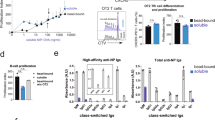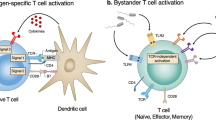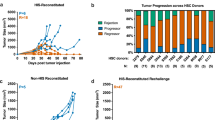Abstract
It is commonly believed that only T lymphocytes and B lymphocytes expressing recombination-dependent antigen-specific receptors mediate contact hypersensitivity responses to haptens. Here we found that mice devoid of T cells and B cells demonstrated substantial contact hypersensitivity responses to 2,4-dinitrofluorobenzene and oxazolone. Those responses were adaptive in nature, as they persisted for at least 4 weeks and were elicited only by haptens to which mice were previously sensitized. No contact hypersensitivity was induced in mice lacking all lymphocytes, including natural killer cells. Contact hypersensitivity responses were acquired by such mice after adoptive transfer of natural killer cells from sensitized donors. Transferable hapten-specific memory resided in a Ly49C-I+ natural killer subpopulation localized specifically in donor livers. These observations indicate that natural killer cells can mediate long-lived, antigen-specific adaptive recall responses independent of B cells and T cells.
This is a preview of subscription content, access via your institution
Access options
Subscribe to this journal
Receive 12 print issues and online access
$209.00 per year
only $17.42 per issue
Buy this article
- Purchase on Springer Link
- Instant access to full article PDF
Prices may be subject to local taxes which are calculated during checkout








Similar content being viewed by others
References
Janeway, C.A., Jr . & Medzhitov, R. Innate immune recognition. Annu. Rev. Immunol. 20, 197–216 (2002).
Jung, D. & Alt, F.W. Unraveling V(D)J recombination; insights into gene regulation. Cell 116, 299–311 (2004).
Bassing, C.H., Swat, W. & Alt, F.W. The mechanism and regulation of chromosomal V(D)J recombination. Cell 109, S45–S55 (2002).
Kurtz, J. Specific memory within innate immune systems. Trends Immunol. 26, 186–192 (2005).
Bloch, B. The role of idiosyncracy and allergy in dermatology. Arch. Dermat. Syph. 19, 175–197 (1929).
Asherson, G.L. & Ptak, W. Contact and delayed hypersensitivity in the mouse. (I) Active sensitivity and passive transfer. Immunology 15, 405–416 (1968).
Askenase, P.W. Yes T cells, but three different T cells (αβ, γδ and NK T cells), and also B-1 cells mediate contact sensitivity. Clin. Exp. Immunol. 125, 345–350 (2001).
Wang, B., Feliciani, C., Freed, I., Cai, Q. & Sauder, D.N. Insights into molecular mechanisms of contact hypersensitivity gained from gene knockout studies. J. Leukoc. Biol. 70, 185–191 (2001).
Marchal, G., Seman, M., Milon, G., Truffa-Bachi, P. & Zilberfarb, V. Local adoptive transfer of skin delayed-type hypersensitivity initiated by a single T lymphocyte. J. Immunol. 129, 954–958 (1982).
Hochgeschwender, U. et al. Dominance of one T-cells receptor in the H-2Kb/TNP response. Nature 326, 307–309 (1987).
Iglesias, A., Hansen-Hagge, T., von Bonin, A. & Weltzien, H.U. Increased frequency of 2,4,6-trinitrophenyl (TNP)-specific, H-2b-restricted cytotoxic T lymphocyte precursors in transgenic mice expressing a T cell receptor chain gene from an H-2b-restricted, TNP-specific cytolytic T cell clone. Eur. J. Immunol. 22, 335–341 (1992).
Bajory, Z., Hutter, J., Krombach, F. & Messmer, K. New method: the intravital videomicroscopic characteristics of the microcirculation of the urinary bladder in rats. Urol. Res. 30, 148–152 (2002).
Phanuphak, P., Moorhead, J.W. & Claman, H.N. Tolerance and contact sensitivity to DNFB in mice. I. In vivo detection by ear swelling and correlation with in vitro cell stimulation. J. Immunol. 112, 115–123 (1974).
Shinkai, Y. et al. RAG-2-deficient mice lack mature lymphocytes owing to inability to initiate V(D)J rearrangement. Cell 68, 855–867 (1992).
Boehncke, W.H. et al. Leukocyte extravasation as a target for anti-inflammatory therapy - Which molecule to choose? Exp. Dermatol. 14, 70–80 (2005).
MacDougall, J.R., Croy, B.A., Chapeau, C. & Clark, D.A. Demonstration of a splenic cytotoxic effector cell in mice of genotype SCID/SCID.BG/BG. Cell. Immunol. 130, 106–117 (1990).
Cao, X. et al. Defective lymphoid development in mice lacking expression of the common cytokine receptor γ chain. Immunity 2, 223–238 (1995).
Goldman, J.P. et al. Enhanced human cell engraftment in mice deficient in RAG2 and the common cytokine receptor γ chain. Br. J. Haematol. 103, 335–342 (1998).
Young, W.W., Jr ., Hakomori, S.I., Durdik, J.M. & Henney, C.S. Identification of ganglio-N-tetraosylceramide as a new cell surface marker for murine natural killer (NK) cells. J. Immunol. 124, 199–201 (1980).
Schott, E., Bonasio, R. & Ploegh, H.L. Elimination in vivo of developing T cells by natural killer cells. J. Exp. Med. 198, 1213–1224 (2003).
Herzog, W.R., Meade, R., Pettinicchi, A., Ptak, W. & Askenase, P.W. Nude mice produce a T cell-derived antigen-binding factor that mediates the early component of delayed-type hypersensitivity. J. Immunol. 142, 1803–1812 (1989).
Vermijlen, D. et al. High-density oligonucleotide array analysis reveals extensive differences between freshly isolated blood and hepatic natural killer cells. Eur. J. Immunol. 34, 2529–2540 (2004).
Zhao, Y., Ohdan, H., Manilay, J.O. & Sykes, M. NK cell tolerance in mixed allogeneic chimeras. J. Immunol. 170, 5398–5405 (2003).
Biedermann, T. et al. Mast cells control neutrophil recruitment during T cell-mediated delayed-type hypersensitivity reactions through tumor necrosis factor and macrophage inflammatory protein 2. J. Exp. Med. 192, 1441–1452 (2000).
Lanier, L.L. NK cell recognition. Annu. Rev. Immunol. 23, 225–274 (2005).
Kim, S. et al. Licensing of natural killer cells by host major histocompatibility complex class I molecules. Nature 436, 709–713 (2005).
Hanke, T. et al. Direct assessment of MHC class I binding by seven Ly49 inhibitory NK cell receptors. Immunity 11, 67–77 (1999).
Catalina, M.D. et al. The route of antigen entry determines the requirement for L-selectin during immune responses. J. Exp. Med. 184, 2341–2351 (1996).
Staite, N.D., Justen, J.M., Sly, L.M., Beaudet, A.L. & Bullard, D.C. Inhibition of delayed-type contact hypersensitivity in mice deficient in both E-selectin and P-selectin. Blood 88, 2973–2979 (1996).
Grabbe, S. et al. β2 integrins are required for skin homing of primed T cells but not for priming naive T cells. J. Clin. Invest. 109, 183–192 (2002).
Raulet, D.H. Roles of the NKG2D immunoreceptor and its ligands. Nat. Rev. Immunol. 3, 781–790 (2003).
Gasser, S., Orsulic, S., Brown, E.J. & Raulet, D.H. The DNA damage pathway regulates innate immune system ligands of the NKG2D receptor. Nature 436, 1186–1190 (2005).
Bangert, C., Friedl, J., Stary, G., Stingl, G. & Kopp, T. Immunopathologic features of allergic contact dermatitis in humans: participation of plasmacytoid dendritic cells in the pathogenesis of the disease? J. Invest. Dermatol. 121, 1409–1418 (2003).
Hunger, R.E., Yawalkar, N., Braathen, L.R. & Brand, C.U. The HECA-452 epitope is highly expressed on lymph cells derived from human skin. Br. J. Dermatol. 141, 565–569 (1999).
von Andrian, U.H. & Mackay, C.R. T-cell function and migration. Two sides of the same coin. N. Engl. J. Med. 343, 1020–1034 (2000).
Cumberbatch, M., Dearman, R.J., Griffiths, C.E. & Kimber, I. Epidermal Langerhans cell migration and sensitisation to chemical allergens. APMIS 111, 797–804 (2003).
Rennert, P.D. et al. Essential role of lymph nodes in contact hypersensitivity revealed in lymphotoxin-α-deficient mice. J. Exp. Med. 193, 1227–1238 (2001).
Martin-Fontecha, A. et al. Induced recruitment of NK cells to lymph nodes provides IFN-γ for TH1 priming. Nat. Immunol. 5, 1260–1265 (2004).
Degli-Esposti, M.A. & Smyth, M.J. Close encounters of different kinds: dendritic cells and NK cells take centre stage. Nat. Rev. Immunol. 5, 112–124 (2005).
Weninger, W. et al. Specialized contributions by α(1,3)-fucosyltransferase-IV and FucT-VII during leukocyte rolling in dermal microvessels. Immunity 12, 665–676 (2000).
Morris, M.A. & Ley, K. Trafficking of natural killer cells. Curr. Mol. Med. 4, 431–438 (2004).
Robert, C. & Kupper, T.S. Inflammatory skin diseases, T cells, and immune surveillance. N. Engl. J. Med. 341, 1817–1828 (1999).
Geissmann, F. et al. Intravascular immune surveillance by CXCR6+ NKT cells patrolling liver sinusoids. PLoS Biol. 3, e113 (2005).
Raulet, D.H. Interplay of natural killer cells and their receptors with the adaptive immune response. Nat. Immunol. 5, 996–1002 (2004).
Proteau, M.F., Rousselle, E. & Makrigiannis, A.P. Mapping of the BALB/c Ly49 cluster defines a minimal natural killer cell receptor gene repertoire. Genomics 84, 669–677 (2004).
Jamieson, A.M. et al. The role of the NKG2D immunoreceptor in immune cell activation and natural killing. Immunity 17, 19–29 (2002).
Pancer, Z. et al. Somatic diversification of variable lymphocyte receptors in the agnathan sea lamprey. Nature 430, 174–180 (2004).
Galli, S.J. & Hammel, I. Unequivocal delayed hypersensitivity in mast cell-deficient and beige mice. Science 226, 710–713 (1984).
Raff, M.C. Role of thymus-derived lymphocytes in the secondary humoral immune response in mice. Nature 226, 1257–1258 (1970).
Snippe, H., Willems, P.J., Graven, W.G. & Kamp, E. Delayed hypersensitivity in the mouse induced by hapten-carrier complexes. Immunology 28, 897–907 (1975).
Bour, H. et al. Major histocompatibility complex class I-restricted CD8+ T cells and class II-restricted CD4+ T cells, respectively, mediate and regulate contact sensitivity to dinitrofluorobenzene. Eur. J. Immunol. 25, 3006–3010 (1995).
Andrews, D.M., Scalzo, A.A., Yokoyama, W.M., Smyth, M.J. & Degli-Esposti, M.A. Functional interactions between dendritic cells and NK cells during viral infection. Nat. Immunol. 4, 175–181 (2003).
Fernandez, N.C. et al. Dendritic cells directly trigger NK cell functions: cross-talk relevant in innate anti-tumor immune responses in vivo. Nat. Med. 5, 405–411 (1999).
Szczepanik, M. et al. γδ T cells from tolerized αβ T cell receptor (TCR)-deficient mice inhibit contact sensitivity-effector T cells in vivo, and their interferon-γ production in vitro. J. Exp. Med. 184, 2129–2139 (1996).
Mora, J.R. et al. Selective imprinting of gut-homing T cells by Peyer's patch dendritic cells. Nature 424, 88–93 (2003).
Shaw, S.G., Maung, A.A., Steptoe, R.J., Thomson, A.W. & Vujanovic, N.L. Expansion of functional NK cells in multiple tissue compartments of mice treated with Flt3-ligand: implications for anti-cancer and anti-viral therapy. J. Immunol. 161, 2817–2824 (1998).
Acknowledgements
We thank G. Cheng and B. Reinhardt for technical assistance; P. Schaerli for assistance in the design of ear sheet culture experiments; J. Lieberman, K. Rajewsky, F. Alt, D. Mathis and D. Podolsky for critical reading of the manuscript; and F. Alt for providing some of the Rag2−/− mice used. Supported by the American Association for the Study of Liver Diseases (J.G.O.) and the National Institutes of Health (AI061663, HL56949 and AR42689 to U.H.v.A.; T32 DK007191 to J.G.O.; T32 HL066987 to M.G.; and T32 AR07098-31 to D.L.D.).
Author information
Authors and Affiliations
Corresponding author
Ethics declarations
Competing interests
The authors declare no competing financial interests.
Rights and permissions
About this article
Cite this article
O'Leary, J., Goodarzi, M., Drayton, D. et al. T cell– and B cell–independent adaptive immunity mediated by natural killer cells. Nat Immunol 7, 507–516 (2006). https://doi.org/10.1038/ni1332
Received:
Accepted:
Published:
Issue Date:
DOI: https://doi.org/10.1038/ni1332
This article is cited by
-
Chimeric antigen receptor engineered natural killer cells for cancer therapy
Experimental Hematology & Oncology (2023)
-
Autologous dendritic cell vaccination against HIV-1 induces changes in natural killer cell phenotype and functionality
npj Vaccines (2023)
-
Roles of natural killer cells in immunity to cancer, and applications to immunotherapy
Nature Reviews Immunology (2023)
-
Transcriptomic perspectives of memory-like NK cells and aging
Genome Medicine (2022)
-
Advances in NK cell production
Cellular & Molecular Immunology (2022)



